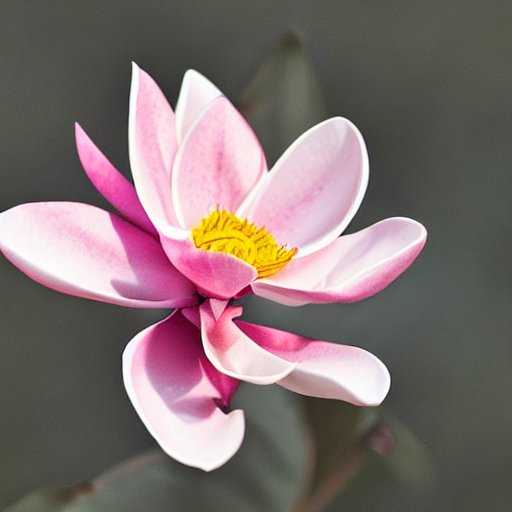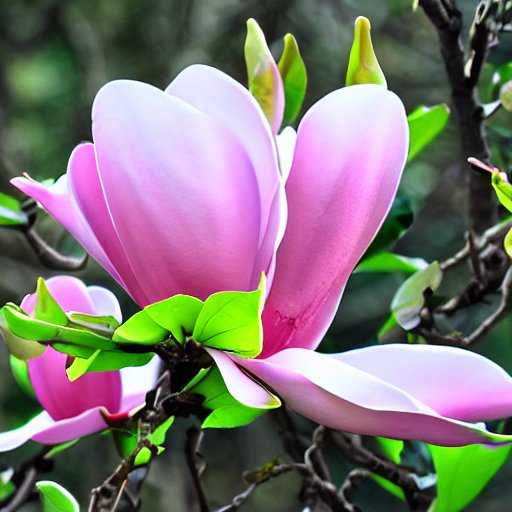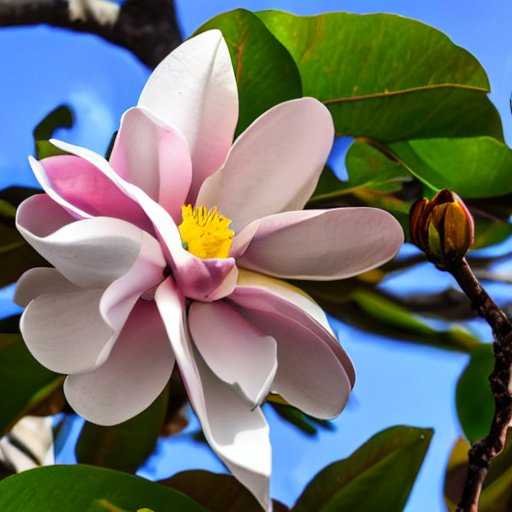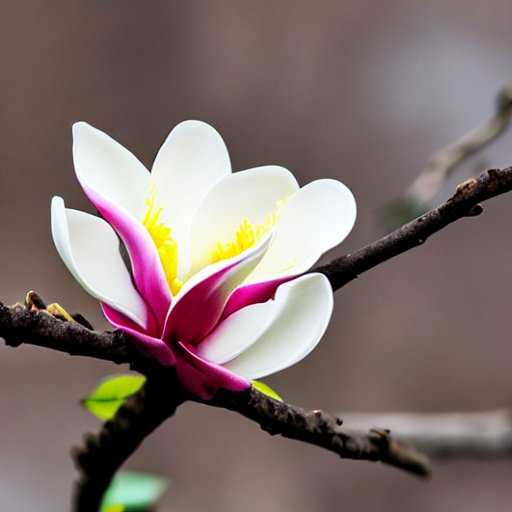How long do magnolia trees live for? Magnolia trees live between 80 and 100 years on average, but with good care, some can live up to 120 years. But the exact length of time a magnolia tree lives depends on things like where it is planted and how much wind and sunlight it gets.
First of all, the lifespan of a magnolia depends on the particular species. For example, the average longevity of Southern magnolias (Magnolia grandiflora) is around 80 years, however there have been reports of these trees surviving far longer.
Furthermore, outside elements like the planting location might make a big difference. Magnolia trees are more likely to flourish and maybe live longer when planted in ideal circumstances, such as well-drained soil and plenty of sunshine. However, exposure to adverse conditions, such as high winds, may damage the tree and reduce its lifespan.
The flowering cycle of magnolia trees is another fascinating factor to take into account. The majority of magnolias don’t begin to bloom until they are around 10 years old. Magnolias are famed for their profuse flowering, which usually starts at this time, but they may produce blooms when they are younger.
Not only is the lifetime of the tree noteworthy, but so is the very lengthy lifespan of magnolia blossoms. Magnolia flowers, once cut, may keep their beautiful form and vibrant color for up to five days. The everlasting beauty of magnolia trees adds to their charm and increases their value among lovers and gardeners.
The stunning, sophisticated, and alluring aroma of magnolia flowers are well known. It is understandable why they are still a popular flower today since these gorgeous blooms have captivated the hearts of many. Have you ever thought about how long these gorgeous flowers endure, though? Let’s look at the lifetime of magnolia flowers and learn more about these amazing flowers.
| Tips to Extend Blooming Time | Additional Tips for Trees |
|---|---|
| 1. Choose Optimal Blooms | 7. Deep Watering for Trees |
| – Select blossoms just beginning… | – Deep water the magnolia tree 2-3 times weekly. |
| – Cut early in the morning for… | – Ensure adequate moisture for growth. |
| 2. Proper Stem Trimming | 8. Protect from Late Frosts |
| – Trim stems at a 45-degree angle. | – Guard against late frosts to prevent bud damage. |
| – Remove excess leaves to prevent… | – Use covers or frost cloth during cold spells. |
| 3. Hydrate in Clean Water | 9. Pruning and Deadheading |
| – Place in a vase with clean water. | – Regularly prune and deadhead for new flower buds. |
| – Change water every 2-3 days. | – Perform early-season pruning for optimal results. |
| 4. Refrigerate Wisely | |
| – Store in the refrigerator,… | |
| – Use the vegetable crisper, away… | |
| 5. Temperature and Humidity Control | |
| – Maintain 32°F to 50°F (0°C to 10°C)… | |
| – Use humidity control or a damp… | |
| 6. Regular Maintenance | |
| – Check for wilting or dehydration… |
Magnolia Flower Lifespan
Magnolia trees typically have a lifespan of 80 to 100 years, but some can live up to 120 years with the right care. But depending on where it is planted, how much wind it gets, and how much sunlight it gets, a magnolia tree’s lifespan can change.
Magnolia flower lifespan is extraordinarily when extended after they are cut initially. Once pruned, magnolia blooms may keep their form and vibrant color for up to five days. The fact that these flowers are still alive after all these years is a tribute to their strength and beauty. Therefore, you can be sure that magnolias will maintain their appeal for many days if you want to use them in floral arrangements or bouquets.
What about the tree’s own magnolia blooms, though? A magnolia tree’s bloom typically lasts for two to three weeks. The flowers begin to bloom at this time and remain on the plant for about two weeks before ultimately dropping off. Due to the rather lengthy blooming period, lovers have plenty of opportunity to bask in the beauty of these lovely flowers.
The glossy white to pink petals of magnolia flowers are one of its distinctive characteristics. As the leaves of the magnolia tree do not immediately emerge into the sun after flowering, these petals are more distinct and bright. Because of this distinctive quality, magnolia flowers are even more alluring and genuinely enchanting.
These beautiful blooms’ habitats, magnolia trees, also have a lifetime. According to popular belief, the majority of Southern magnolia trees (Magnolia grandiflora) live between 80 and 120 years. The range of magnolia trees has sometimes been exceeded, nevertheless. A magnolia tree in Italy is known to have lasted for an incredible 320 years, demonstrating the durability of these grand plants. Also removed from the White House in 2017 was a historic southern magnolia tree said to be roughly 190 years old. These instances demonstrate the incredible tenacity of magnolia trees and their capacity to enrich our lives for many years.
Magnolia flowers may sometimes begin to wilt and wither. After a few days of blooming, the flowers go through this natural process. Magnolia flowers often only endure a few days before becoming a dusty brown tint and then disintegrating to the ground. It’s important to remember that this is a typical stage in the flower’s life cycle. Furthermore, warmer temperatures in the early spring might hasten the demise of magnolia blooms. Therefore, even if their beauty may be temporary, it is still important to enjoy them while they are around.

It’s crucial to understand how to properly care for a magnolia tree if you’re fortunate enough to have one in your yard. An essential part of maintaining magnolia trees is pruning. To prevent cutting off any prospective flowers, it’s essential to trim the tree after it has done blossoming. You may shape the tree to your tastes and enhance its general health and vitality by trimming at the proper moment.
There are a few pointers to keep in mind to extend the life of cut magnolia flowers. The flowers should first be kept out of direct sunshine since too much heat might hasten their fading. Changing the vase’s water every few days also helps in preserving the flowers’ freshness and extending their life. You may enjoy the beauty and aroma of magnolia flowers for at least a week by following these easy instructions.
It’s important to note that different magnolia species bloom at various periods of the year. After the first bloom, some magnolias even develop a second flush of flowers. By extending the flowering season, magnolias may exhibit their grandeur from early spring to late summer, giving landscapes more diversity and appeal.
How Long Does a Magnolia Flower Last?
Most Magnolia flowers last about two to three weeks before they die and fall off the plant. This time frame can change, though, based on the weather and the type of Magnolia.
Normally, the blooms appear and remain on the plant for around two weeks until they finally fall off. The white to pink blossoms have a glossy look and are quite apparent at this time. It’s important to note that after flowering, the leaves do not instantly come out into the light, which highlights how lovely these blossoms are even more.
The difference in flowering periods between various Magnolia seedlings is an intriguing factor to take into account. One seedling can take up to fifteen or twenty years to blossom, whilst another might begin to bloom after only three years. These exquisite blooms are all the more intriguing because of their considerable variation in blossoming seasons.
If there isn’t a late frost to interfere, flowering usually lasts for three weeks. Because of their extreme sensitivity to late frosts, magnolias may experience an early browning of their blossoms. Therefore, you should take extra care to safeguard your magnolia flowers if you live in an area that is prone to late frosts.
Most deciduous magnolias bloom in the early to late spring; some even continue to bloom into the summer on occasion. Additionally, a large number of hybrid types have been created, each with distinct blooming patterns and traits.
Even though the magnolia bloom exhibit is short—just a week or two—it is very magnificent. These blossoms are all the more spectacular since they often occur before the trees leaf out in the spring. Magnolia flowers should endure for at least a week if you wish to cut and display them; just be sure to keep them out of direct sunlight and refresh the water every few days.

How Long Do Magnolia Plants Live?
According to popular belief, the average lifespan of southern magnolia trees is between 80 and 120 years. Magnolia trees have sometimes survived outside of this region, however this is quite rare. For example, the oldest known magnolia tree, which is located in Italy, is an amazing 320 years old.
Variations Among Magnolia Species
It’s important to remember that magnolia tree lifespans might vary based on the species. For instance, southern magnolias often survive for 80 years on average. The only way to know for sure is to check out the website. Some magnolia trees have been known to flourish and survive for a very long time under the right circumstances.
The Impact of Care and Maintenance
Magnolia trees, like any other living thing, need upkeep and care to survive. These towering trees may live as long as they possibly can with the right care. Magnolia trees may thrive and extend their lives with the proper care, which includes watering, fertilizing, trimming, and protection from diseases and pests.
Factors Influencing Magnolia Tree Longevity
Several factors come into play when considering the lifespan of a magnolia tree. Here are some key elements that can impact their longevity:
- Species and Variety: The life periods of various magnolia species and cultivars might vary. It is crucial to choose a variety appropriate for your area and intended lifetime.
- Magnolias like certain types of temperatures and environments for optimum growth. Their general health and longevity will benefit from the provision of a setting that closely resembles their native habitat.
- The best soil for magnolias is wet and well-drained. Ample watering promotes lifespan and helps preserve their vigor, particularly during dry spells.
- Magnolias prefer full sun exposure, although some species may tolerate slight shade. Knowing how much sunshine your particular magnolia tree needs to thrive and live a long life is essential.
- Magnolias grow well in well-drained soil that holds moisture without becoming soggy. In order to encourage healthy development and a longer lifetime, it is important to ensure that the soil is nutrient-rich and has excellent drainage.
Planting and Growing Magnolia Trees
If you’re considering adding a magnolia tree to your garden, it’s important to understand the planting and growing process. Here are some guidelines to help you get started:
- Choosing the Right Time: Late spring or early autumn are the ideal times to grow magnolia trees. These times of year provide ideal circumstances for the formation of their roots.
- Patience is Key Magnolias are trees that develop slowly; it may take them 10 to 20 years to reach their maximum height. However, the wait was well worth it due to their beauty and elegance.
- Proper Identification: Make sure you are aware of the precise species and variation of your magnolia tree before planting it. You may modify your cleaning and maintenance procedures using this information to guarantee the life of the system.
The Splendor of Magnolia Trees
Not only are magnolia trees renowned for their long lifespans, but also for the beauty and majesty of their flowers. Some types may reach heights of up to 100 feet and survive for 200 years, making them real representations of tenacity and the beauty of nature. Read the plant tag or description or get advice from nearby gardening professionals to pick the ideal magnolia tree for your landscape.
Can Magnolia Flower Twice a Year?

Once a magnolia tree reaches maturity, it often starts to bloom annually. Early spring is usually when this first bloom appears, releasing its lovely smell and bringing a burst of color to the surroundings.
Saucer Magnolia blooms twice in the same year, however only under particular situations. Even though this incidence is uncommon, it has sometimes been noted. There are a few things that might cause a magnolia tree to bloom twice, yet the precise causes of this occurrence are still not entirely known.
The genetic make-up of a magnolia tree is one aspect that might cause it to bloom twice. Magnolia bloom patterns vary across species and cultivars. While certain types are more likely to bloom only once during their assigned flowering time, others are more likely to produce a second flush of flowers. An individual magnolia tree’s genetic characteristics may have a considerable impact on whether or not it can produce many flowers.
Do you cut off dead magnolia flowers?

You should cut off dead magnolia flowers after the initial bloom that allows you to assess the overall shape and growth pattern of the tree. You may choose which branches to cut and how to attain the desired shape by paying attention to how it naturally grows. This strategy guarantees that you may encourage healthy development while preserving the tree’s aesthetic appeal.
When to Prune Magnolia Trees: The right time to prune your magnolia tree is essential to its health. The best times to trim magnolia trees are either early spring or late winter, following the last frost. Because the tree is still asleep at this time, it may recover from the pruning procedure more quickly. Pruning now reduces stress on the tree and encourages new development the following season.
How do you keep a magnolia bloom?
here’s a guide on how to extend the lifespan of your magnolia blooms.
1. Prune with Precision
Pruning magnolias requires prudence because of their delicate nature. Although they don’t need a lot of pruning, it’s crucial to cut off any broken branches and, if required, shape the tree. To maintain the health and aesthetic appeal of your magnolia, prune sparingly and only when absolutely essential.
2. Minimize Foot Traffic
Reduce foot traffic at the base of your magnolia tree to preserve its health and lifespan. Excessive trampling may compress the ground around the tree and damage its sensitive root structure. You can protect the tree’s general health and guarantee that it continues to produce lovely blooms by limiting foot activity.
3. Careful Cutting and Conditioning
Techniques for cutting and conditioning flowers from magnolias are essential when gathering them for indoor display. Cut blooms in the early morning hours, when the temperature is cooler, when they are just starting to open. To achieve a clean cut at a little angle, use sharp, clean pruning shears.
It’s crucial to thoroughly condition the flowers once you’ve cut them. The magnolia stems should be immediately placed in a container that has been filled with warm water. Put a transparent plastic bag over the container to keep the moisture in. Before arranging the blooms, let them a few hours to rest in a cool, shady area.
4. Hydration and Nutrition
Proper nourishment and hydration are crucial for maintaining your magnolia blooms in their finest condition. Regularly water the tree to keep the soil wet, but take care not to overwater as this might harm the flower’s fragile roots. Additionally, you may add a spoonful of sugar to the water to nurture the blooms and lengthen the time that they remain fresh.
5. Protect from Direct Sunlight
Because they are sensitive to direct sunshine, magnolias’ delicate petals may prematurely wither and fade. If you want to exhibit cut magnolia blooms inside, make sure they are away from direct sunlight. In addition to extending their longevity, this will help retain the beautiful hues of the plants.
6. Change the Water Regularly
Every two to three days, you should replace the water in the container holding your magnolia blooms to keep them fresh. By doing this, you stop germs from growing and guarantee that the flowers have access to sterile, oxygen-rich water. To extend the life of the flowers, think about adding floral preservatives to the water.
7. Refrigeration for Prolonged Enjoyment
Refrigeration might be a useful solution if you want to extend the life of your cut magnolia blooms over a week. You may put the flowers in the refrigerator after conditioning them as previously suggested. You may be able to extend the time that your magnolia flowers bloom by taking advantage of this chilly atmosphere, which helps to slow down the blooming process.
8. Appreciate the Beauty
Last but not least, savor the alluring beauty of your magnolia blooms. These flowers are a genuine gift from nature, and their transience makes them much more priceless. No matter how many magnolia trees you have or how many cut flowers you have, treasure them and the magical moments they provide.
In conclusion, magnolia flower lifespan is long and they are one of beautiful and long-lasting trees. These stunning blooms never fail to catch our hearts and astonish us, whether they are decorating a floral arrangement or gracing a landscape. The term “magnolia” refers to a kind of flower that is used to describe a plant. Take a minute to enjoy the transient but beautiful beauty that these flowers provide to the world the next time you see a flowering magnolia.
Related Posts:
How Tall Do Southern Magnolia Trees Grow?
Magnolia flower Meaning And Symbolism
How to Propagate a Magnolia Tree From Seed?
30 of the Best Magnolia Varieties to Try
How to Propagate Magnolia Tree From Cuttings?
How Messy Are Southern Magnolia Trees?
Reference:
https://extension.missouri.edu/news/magnolia-flowers-tantalize-the-senses-6053
